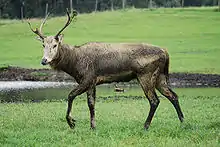Cervinae
The Cervinae or the Old World deer (denoting their place of origin, not their current distribution), are a subfamily of deer. Alternatively, they are known as the plesiometacarpal deer, due to their ankle structure being different from the telemetacarpal deer of the Capreolinae.
| Cervinae Temporal range: Late Miocene to recent | |
|---|---|
 | |
| Père David's Deer (Elaphurus davidianus) | |
| Scientific classification | |
| Kingdom: | Animalia |
| Phylum: | Chordata |
| Class: | Mammalia |
| Order: | Artiodactyla |
| Family: | Cervidae |
| Subfamily: | Cervinae Goldfuss, 1820 |
| Genera | |
Classification and species
The list is based on the studies of Randi, Mucci, Claro-Hergueta, Bonnet and Douzery (2001); Pitraa, Fickela, Meijaard, Groves (2004); Ludt, Schroeder, Rottmann and Kuehn (2004); Hernandez-Fernandez and Vrba (2005); Groves (2006); Ruiz-Garcia, M., Randi, E., Martinez-Aguero, M. and Alvarez D. (2007); Duarte, J.M.B., Gonzalez, S. and Maldonado, J.E. (2008); Groves and Grubb (2011)[1]
- Tribe Muntiacini
- Genus Elaphodus
- Tufted deer (E. cephalophus)
- Genus Muntiacus
- Bornean yellow muntjac (M. atherodes)
- Hairy-fronted muntjac (M. crinifrons)
- Fea's muntjac (M. feae)
- Gongshan muntjac (M. gongshanensis)
- Indian muntjac (M. muntjak)
- Sumatran muntjac (M. montanum)
- Pu Hoat muntjac (M. puhoatensis)
- Leaf muntjac (M. putaoensis)
- Reeves's muntjac (M. reevesi)
- Roosevelt's muntjac (M. rooseveltorum)
- Truong Son muntjac or Annamite muntjac (M. truongsonensis)
- Giant muntjac (M. vuquangensis)
- Genus Elaphodus
- Tribe Cervini ("true" deer)
- Genus Dama
- Fallow deer (D. dama)
- Persian fallow deer (D. mesopotamica)
- Genus Axis
- Chital (A. axis)
- Genus Rucervus
- Barasingha (R. duvaucelii)
- †Schomburgk's deer (R. schomburgki)
- Genus Panolia[2]
- Eld's deer (P. eldii)
- Genus Elaphurus
- Père David's deer (E. davidianus)
- Genus Hyelaphus[2]
- Indochinese hog deer (H. annamiticus)
- Calamian deer (H. calamianensis)
- Bawean deer (H. kuhlii)
- Indian hog deer (H. porcinus)
- Genus Rusa
- Visayan spotted deer or Prince Alfred's deer (R. alfredi)
- Philippine deer or Philippine sambar (R. mariannus)
- Javan rusa deer (R. timorensis)
- Sri Lankan sambar (R. unicolor)
- Genus Cervus
- Thorold's deer (C. albirostris)
- Elk or American wapiti (C. canadensis)
- Red deer (C. elaphus)
- Central Asian red deer (C. hanglu)
- Sika deer (C. nippon)
- Genus Dama
References
- "Archived copy". Archived from the original on 2012-12-01. Retrieved 2013-01-23.CS1 maint: archived copy as title (link)
- Pitraa, Fickela; Meijaard, Groves (2004). "Evolution and phylogeny of old world deer" (PDF). Molecular Phylogenetics and Evolution. 33 (3): 880–895. doi:10.1016/j.ympev.2004.07.013. PMID 15522810. Archived from the original (PDF) on 2007-06-12.
This article is issued from Wikipedia. The text is licensed under Creative Commons - Attribution - Sharealike. Additional terms may apply for the media files.
